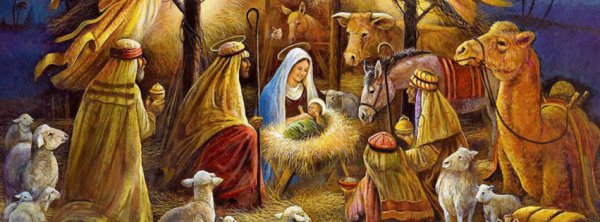
In the years that I have been writing for the Pulse, the December issue has always been my favorite. The stories I have shared during this time were the most personal and heartfelt stories I have been able to bring forth to date. The reason for this is because they happened to me; most were derived from personal experiences that moved me in some way or another. For those who are not familiar, a few examples include working for Toys for Tots, playing Santa Claus for family and friends, and various things that taught me the meaning of Christmas . . . or did they?
Yes, I know the meaning of the spirit of Christmas, (at least as I see it); it means to find the good in yourself and your fellow travelers on God’s little blue ball. To bring some joy to children and share some fellowship with loved ones. But, what about the actual meanings—what does the word “Christmas” mean? Who was Santa Claus, really? Why do we give presents? Why do we have Christmas trees? Is it really Jesus’ birthday? And what the heck is a yule log?
I think maybe it’s time to answer some of those questions.
Now, before I begin, this is not a result of years and years of personal research and study. No, this is more of a “Tony didn’t have a great feel-good Christmas story this year, so he busted out some Google time and found something interesting” kinda thing. Also let be it known that I don’t claim the following information to be gospel, just the best info I could find. If you have more insight or opinions, post ’em. I would love to read it.
What is the literal meaning of Christmas?
Mass of Christ.
The term Christmas appeared in Old English as early as 1038 A.D. as Cristes Maesse, and later as Cristes-messe in A.D. 1131. It means “the Mass of Christ.” This name was established by the Christian church to disconnect the holiday and its customs from its pagan origins. As one fourth-century theologian penned, “We hold this day holy, not like the pagans because of the birth of the sun, but because of Him who made it.”
Why is Christmas celebrated on Dec. 25?
Some sources report that Theophilus of Antioch (circa 171–183) was the first to identify Dec. 25 as the birth date of Christ. Others say that Hippolytus (circa 170–236) was the first to claim that Jesus was born on Dec. 25. A strong theory suggests that this date was eventually chosen by the church because it aligned closely with a major pagan festival, Dies Natalis Solis Invicti (birth of the invincible sun god), thus allowing the church to claim a new celebration for Christianity.
 Why do we have Christmas trees?
Why do we have Christmas trees?
Along with the date of Christmas itself, this practice was designed to supplant a pagan ritual. The following is an entry on the Christianity Today website: The evergreen tree was an ancient symbol of life in the midst of winter. Romans decorated their houses with evergreen branches during the New Year, and ancient inhabitants of northern Europe cut evergreen trees and planted them in boxes inside their houses in wintertime. By the early Middle Ages, the legend had grown that when Christ was born in the dead of winter, every tree throughout the world miraculously shook off its ice and snow and produced new shoots of green. At the same time, Christian missionaries preaching to Germanic and Slavic peoples were taking a more lenient approach to cultural practices—such as evergreen trees. These missionaries believed that the Incarnation proclaimed Christ’s lordship over those natural symbols that had previously been used for the worship of pagan gods. Not only individual human beings, but cultures, symbols and traditions could be converted.
 Who was the real Santa Claus?
Who was the real Santa Claus?
The modern figure of Santa Claus is derived from the Dutch figure of Sinterklaas, whose name is a dialectal pronunciation of Saint Nicholas, the historical Greek bishop and gift-giver of Myra. During the Christianization of Germanic Europe, this figure may have absorbed elements of the god Odin, who was associated with the Germanic pagan midwinter event of Yule. Over time, traits of this character and the British folklore character Father Christmas merged to form the modern Santa Claus known today.
Saint Nicholas of Myra was a fourth-century Greek Christian bishop of Myra (now Demre) in Lycia, a province of the Byzantine Anatolia (now a large region of modern Turkey). Nicholas was famous for his generous gifts to the poor, in particular presenting the three impoverished daughters of a pious Christian with dowries so that they would not have to become prostitutes. He was very religious from an early age and devoted his life entirely to Christianity. In continental Europe (more precisely the Netherlands, Belgium, Austria and Germany) he is usually portrayed as a bearded bishop in canonical robes. The Santa Claus we know today is, of course, a more modern invention, but he still has the beard, and some images display Saint Nick/Santa Claus in red robes.
Why do we give Christmas presents?
One of the main reasons we have the custom of giving and receiving presents at Christmas is to remind us of the presents given to Jesus by the wise men: frankincense, gold and myrrh. (It’s also possible that gift-giving is a tradition that was passed down from a very, very long time ago before Christmas even existed, when the people who lived in what is now Italy (Ancient Romans) gave gifts during winter.)
 What are myrrh and frankincense?
What are myrrh and frankincense?
Myrrh (mur), is the aromatic resin of a number of small, thorny tree species which has been used throughout history as a perfume, incense and medicine. It can also be ingested by mixing it with wine.
Frankincense was a perfume used in Jewish worship and as a gift item. A rare and precious herb, it was a symbol that the baby Jesus was a king worthy of worship.
 What is a yule log, and why do we burn it at Christmastime?
What is a yule log, and why do we burn it at Christmastime?
I was able to find this info at whychristmas.com: The custom of burning the Yule Log goes back to, and before, medieval times. It was originally a Nordic tradition. Yule is the name of the old Winter Solstice festivals in Scandinavia and other parts of northern Europe, such as Germany. The yule log was originally an entire tree that was carefully chosen and brought into the house with great ceremony. The largest end of the log would be placed into the fire hearth while the rest of the tree stuck out into the room! The log would be lit from the remains of the previous year’s log, which had been carefully stored away and slowly fed into the fire through the Twelve Days of Christmas.
So, there you have it, some of the mystery of Christmas explained. I gave the brief explanations here but there is a lot more information out there. The sites I mentioned, as well as Wikipedia, have tons of facts about the very interesting history of Christmas. The most striking thing about Christmas is how much of its origins revolve around pagan holidays and converting them to Christianity.
In closing, I’d like to wish each and every one of you a very merry Christmas (however you choose to celebrate it) and that you and your loved are happy and prosperous for your next trip around the sun . . . including the pagans.













